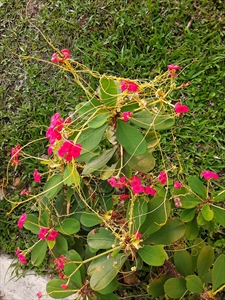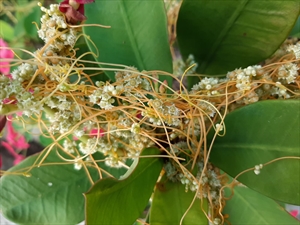- Widespread. Asia, Africa, North, South, Central America, the Caribbean, Europe, Oceania. In Australia and many Pacific island countries.
- Parasitic plant on ornamentals and broadleaved weeds, weakening hosts by smothering and feeding. Losses poorly recorded. Potential for poisoning horses and cattle fed contaminated hay. ‘Environmental’ weed, growing on native vegetation in grasslands, woodlands, riverbanks and wetlands.
- Stems smooth, leaves reduced to scales, branches (tendrils) with suckers (haustoria) for attaching/feeding. Flowers white or cream, 3-4 mm diameter, with round fruits each with four seeds. Seeds last long in soil, but after germination must reach host within few days or die. Flowers within 2 weeks of germination.
- Spread as seeds in plant debris, flood water, on machinery, in guts of animals; spread over long distances in contaminated seed lots of, e.g., sorghum, lucerne, clover, and niger (or nyjer) bird seed.
- Biosecurity: regulate as noxious weed and ensure imported seed lots are certified free from contamination.
- Cultural control: use certified seed; check fields before planting; remove (but NOT by slashing) before flowering - cut host plants near ground level and burn them on site; map locations and check for regrowth; clean harvesting tools and machinery; rotate with cereals (including maize) or pasture grasses for 3-4 years.
- Chemical control: in Australia, metsulfuron-methyl.






